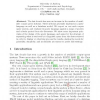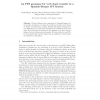100
click to vote
FSMNLP
2005
Springer
15 years 5 months ago
2005
Springer
Abstract. The last decade has seen an increase in the number of available corpus query systems. These systems generally implement a query language as well as a database model. We r...
FSMNLP
2005
Springer
15 years 5 months ago
2005
Springer
Abstract. We present a formalization of lexicalized Recursive Transition Networks which we call Automaton-Based Generative Dependency Grammar (gdg). We show how to extract a gdg fr...
FSMNLP
2005
Springer
15 years 5 months ago
2005
Springer
The join of two n-ary string relations is a main operation regarding to applications. n-Ary rational string relations are realized by weighted finite-state machines with n tapes. ...
FSMNLP
2005
Springer
15 years 5 months ago
2005
Springer
Abstract. Stochastic finite automata are useful for identifying substrings (chunks) within larger units of text. Relevant applications include tokenization, base-NP chunking, name...
108
click to vote
FSMNLP
2005
Springer
15 years 5 months ago
2005
Springer
This paper describes the implementation and system details of Klex, a finite-state transducer lexicon for the Korean language, developed using XRCE’s Xerox Finite State Tool (XF...
105
click to vote
FSMNLP
2005
Springer
15 years 5 months ago
2005
Springer
TAGH is a system for automatic recognition of German word forms. It is based on a stem lexicon with allomorphs and a concatenative mechanism for inflection and word formation. Wei...
FSMNLP
2005
Springer
15 years 5 months ago
2005
Springer
We extend finite state registered automata (FSRA) to account for medium-distance dependencies in natural languages. We provide an extended regular expression language whose expres...
FSMNLP
2005
Springer
15 years 5 months ago
2005
Springer
Abstract. We are working on the construction of a Spanish-Basque (eseu) machine translation tool using the traditional transfer model based on shallow and dependency parsing. Spani...
FSMNLP
2005
Springer
15 years 5 months ago
2005
Springer
This paper presents SFST-PL, a programming language for finite state transducers which is based on extended regular expressions with variables. The programming language is both si...
77
Voted
FSMNLP
2005
Springer
15 years 5 months ago
2005
Springer
Compounding is a very productive process in German to form complex nouns and adjectives which represent about 7% of the words of a newspaper text. Unlike English, German compounds ...






